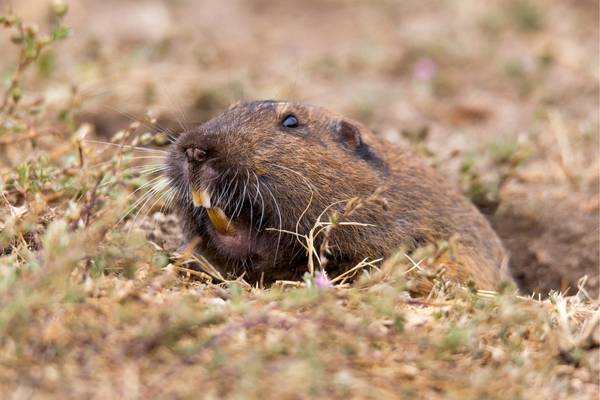Gophers are small, ground-dwelling rodents that are found in North and Central America. They are known for their burrowing abilities and for being pests in gardens and yards. But can gophers swim?
The answer is yes! They can swim and in fact swim pretty well. Like other related rodents, gophers are not afraid of water and are perfectly capable of swimming and even, though more rarely, diving!
Gophers are often found around water sources, such as ponds and lakes. This is because they need to drink water to stay hydrated.
They also use water to help keep their fur clean and free of dirt and debris. When gophers come into contact with water, they will often shake their bodies to dry off.
It is also been said that Gophers can hold their breath for up to 4 minutes when they are underwater. This enables them to stay submerged for a while looking for food or escaping predators. When they come up for air, they will often make a “sneeze” sound to help remove any water from their nostrils.
Even though they are often found near water, gophers are not necessarily happy swimmers. If they fall into a body of water that is too deep, they might drown if there is no easy way to get back on land but they do have an instinct (like human babies do!) to hold their breath when underwater.

This is why it is important for them to stick close to the shoreline when they are near water sources and they tend to only spend a short time in the water as they cannot easily run to hide in their burrows!
Why would gophers go into the water?
They are well-adapted to their environment and have sharp claws that help them dig and move through the soil. While gophers typically avoid water, there are a few reasons why they may enter it.
One reason why gophers may go into the water is to escape predators. Gophers are a prey species, so they must constantly be on the lookout for predators such as hawks, snakes, and foxes. If a gopher sees a predator approaching, it will quickly scurry into its burrow for safety. However, if the predator is blocking the entrance to the burrow, the gopher may try to escape into the nearest water source and attempt swimming away.
Another reason why gophers may enter the water is to find food. Gophers are mostly herbivores, and their diet consists of roots, flowers, and other plant material. If the ground is dry and there is no food available, a gopher may swim to a nearby body of water in search of aquatic plants to eat.
Lastly, gophers may go into the water to cool off or bathe. Gophers are comfortable in temperatures that range from 60-80 degrees Fahrenheit, but they can overheat if the temperature gets too high. If a gopher is feeling hot, it may take a dip in a nearby stream or pond to cool down.
Can gophers breathe underwater?
It is a common misconception that gophers can breathe underwater. No mammals can breathe underwater, but many can hold their breath for extended periods of time!
In reality, gophers are able to hold their breath for up to four minutes at a time, but they will drown eventually. This allows them to stay submerged for extended periods of time if necessary as they have fairly low oxygen requirements.
This is also why they can survive in their tunnels without strong air circulation!
Additionally, gophers have been known to build burrows that extend into bodies of water, indicating that they are comfortable spending time near or in water. Therefore, it is safe to say that gophers cannot hold their breath, but not breathe, underwater.
For how long can gophers hold their breath?
Gophers can hold their breath for up to four minutes, which means they can stay submerged for a pretty long time. This is helpful if they need to escape a predator, find food or survive flooding.

Can you drown a gopher?
Yes, you can drown a gopher if it stays in the water for too long. As we mentioned before, gophers have lungs, and they need to breathe air. If they stay underwater for more than four minutes, they will start to suffocate and eventually die.
Gophers are generally not a threat to humans, but they can be a nuisance if they invade your yard or garden. In some areas, gophers are considered pests because they can damage crops and yards by digging their burrows.
Therefore many people would like to get rid of them and one solution is to flood their burrows. But it will not works well, as gophers have many strategies to deal with heavy rain and flooding.
They have drainage systems and emergency exits that make drowning them very challenging!
Gophers will also eat plants that people are trying to grow. If you have a gopher problem, there are a few things you can do to get rid of them but also many ways to avoid attracting gophers to your yard in the first place!

You can trap them and release them somewhere else, or you can kill them. However, it is illegal to kill gophers in some states, so be sure to check your local laws before taking any action.
How to get rid of gophers?
Instead of killing gophers, I would strongly recommend one of the solutions listed below:
1. Motion-activated sprinklers
Like most animals, gophers hate surprises, and they will run away if suddenly sprayed with water. I like this solution because it is humane, simple, effective, and does not require much time to set up and there are many models to choose from.
My favorite sprinkler option here is the Havahart 5277.
The Havahart 5277 is a motion-activated sprinkler that is activated by the movement of animals up to 25 feet away and sprays them with a harmless water jet, frightening them off and keeping them at bay.
The included metal stake makes it easy to install in your backyard, and the sprinkler can be rotated 180 degrees for maximum coverage.
2. Ultrasonic Sound Emitters
Groundhogs and gophers, as well as other animals that may invade your garden, tend to have very good hearing. This means that loud or consistent noises will scare them away or at least shorten their visits significantly!
One of my favorite technologies to keep pests away from my backyard is these cool solar-powered ultrasonic sound emitters that you can buy right off Amazon! In my experience, they really work, and the solar panels on top save you the time and money of changing batteries all the time.
3. Using Lights and Reflections
Groundhogs are nocturnal animals so they may avoid areas that have bright lights. Motion-activated lights, sounds, and sprinklers may help prevent gophers from entering your yard.
Placing CDs or tin foil and mirrors around your yard is another cheap and effective way to create light reflections that blind and scare gophers.
This may sound a little old-fashioned but it still works! The reflective surface of CDs or tin foil drives gophers crazy and will make them seek away from your plants.
You can use old CDs you no longer need or aluminum trays from takeaway containers, just make sure they reflect light well.
If you have a lot of plants to protect this way, it may be a good idea to invest in some commercial mirrors or electronic light emitters like the ones shown above.
4. Build a Fence
The most obvious and practical solution to protecting your plants from gophers is to install a fence around the patch. A fence should be at least 2 feet tall and sunk in the ground about 8 inches.
The best fencing material for this purpose is a cattle panel or hog panel as they are very sturdy and can withstand even quadruped animals such as goats, cows, and deer. However, most chicken fencing types will do. This will be strong enough to stop them from getting through while still allowing for airflow and sunlight.
If you don’t like the idea of building a fence around your entire onion patch then you can try fencing off only the area that your onions, tomatoes, or zucchinis are in; this will at least keep some of the gophers or gophers away from them.
5. Using Hot Pepper Or Garlic Spray
This is a good way to protect your vegetable plants or decorative flowers against pests such as gophers, rabbits, deer, and gophers. It will also protect your backyard against the neighbor’s cat that thinks it is fine to use your vegetable garden as a toilet.
You only need about 1 tablespoon of crushed chili pepper and garlic along with 1 cup of vinegar per half a gallon of water.
Spray this mixture on any exposed parts of the plant until completely covered. Make sure you reapply whenever rain washes away the spray.
6. Use Rodent Deterring Companion Plants
Instead of making a tincture out of strongly smelling plants, you can also just plant the plants themselves!
Companion planting is a good way of deterring animals like gophers from your garden. You can plant strong-smelling plants such as garlic, basil, lavender, and chives around your favorite vegetables.
These plants will keep rodents like gophers, gophers, and mice away because they don’t like the smell of these and they mask the smell of the delicious plants.
7. Using Artificial Repellent
You can use some of the commercially available repellents to protect your vegetable plants against gophers, gophers, and other rodents. You will need to be careful when using these though because some of them can end up harming you and your pets if not applied properly. Some of the commercial gopher repellents available include Shake-Away, Bonide Repels All, Critter Ridder, and Tom Cate Repellent.
8. Using a Scarecrow
Scarecrows may look a little funny in your garden, but they work surprisingly well. Just make sure your scarecrow is big and scary enough to deter gophers from getting anywhere near your tomatoes, zucchini, or backyard flowers! Also, you may need to replace the scarecrow every now and then as gophers will get used to it.
9. Using live traps
Using live traps to catch the gopher and drive it away to somewhere safe, but far away, is perhaps the best option if you want to get completely rid of gophers in your yard!
You can make a trap yourself with some wire and ingenuity…
But, you can also just buy a live trap, as the sturdy metal ones shown here:
10. Using Mothballs
Mothballs are another type of commercial repellent that works well to protect your vegetables and other plants against gophers but are less effective against gophers.
This is, however, not our favorite technique as it is less effective and risk spreading toxins in your garden.
You just need to scatter a few mothballs around into the tunnels of the gopher or gopher to prevent them from coming out and they will eventually leave your garden!
Just be careful where you scatter the mothballs because the compounds (naphthalene or paradichlorobenzene) are quite toxic so don’t put them too close to vegetables or water sources.
Conclusion
Gophers are small, ground-dwelling rodents that are found in North and Central America. They are known for their burrowing abilities and for being pests in gardens and yards.
Gophers can swim and do in fact swim pretty well. Like other related rodents, gophers are not afraid of water and are perfectly capable of swimming and even, though more rarely, diving!
Gophers may enter the water to escape predators, find food, or cool off. If they stay underwater for more than four minutes, they will start to suffocate and eventually die.
Gophers are generally not a threat to humans, but they can be a nuisance if they invade your yard or garden. In some areas, gophers are considered pests because they can damage crops and yards by digging their burrows.




















